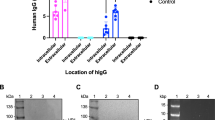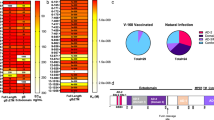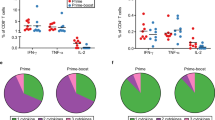Abstract
The gamma-2 herpesvirus of rhesus monkeys, rhesus monkey rhadinovirus (RRV), persists principally in B cells of its host. We constructed recombinant strains of RRV expressing the rhesus monkey-derived anti-SIV monoclonal antibodies 4L6 and 5L7 and compared the RRV-mediated in vivo delivery of these antibodies in rhesus monkeys with previous studies that utilized intramuscular delivery with an adeno-associated virus (AAV) vector. Recombinant RRV-4L6 and RRV-5L7 were both shown to stably produce the antibodies in persistently infected B-cell lines in culture. Two RRV-negative rhesus monkeys were experimentally infected with recombinant RRV-4L6 and two with recombinant RRV-5L7. Following infection, the appearance of the delivered antibody was readily detected in all four animals. However, the levels of the delivered antibody were considerably lower than what has been typically observed following intramuscular AAV delivery. Furthermore, three of the four monkeys had an antibody response to the delivered antibody as had been observed previously with intramuscular AAV delivery of these same antibodies. We conclude that this recombinant herpesvirus has no inherent advantage over AAV for delivery of potentially therapeutic monoclonal antibodies in a rhesus monkey model.
This is a preview of subscription content, access via your institution
Access options
Subscribe to this journal
Receive 12 print issues and online access
$259.00 per year
only $21.58 per issue
Buy this article
- Purchase on Springer Link
- Instant access to full article PDF
Prices may be subject to local taxes which are calculated during checkout




Similar content being viewed by others
References
Fuchs SP, Desrosiers RC . Promise and problems associated with the use of recombinant AAV for the delivery of anti-HIV antibodies. Mol Ther Methods Clin Dev 2016; 3: 16068.
Burton DR, Poignard P, Stanfield RL, Wilson IA . Broadly neutralizing antibodies present new prospects to counter highly antigenically diverse viruses. Science 2012; 337: 183–186.
Corti D, Lanzavecchia A . Broadly neutralizing antiviral antibodies. Annu Rev Immunol 2013; 31: 705–742.
Horwitz JA, Halper-Stromberg A, Mouquet H, Gitlin AD, Tretiakova A, Eisenreich TR et al. HIV-1 suppression and durable control by combining single broadly neutralizing antibodies and antiretroviral drugs in humanized mice. Proc Natl Acad Sci USA 2013; 110: 16538–16543.
Klein F, Halper-Stromberg A, Horwitz JA, Gruell H, Scheid JF, Bournazos S et al. HIV therapy by a combination of broadly neutralizing antibodies in humanized mice. Nature 2012; 492: 118–122.
Klein F, Mouquet H, Dosenovic P, Scheid JF, Scharf L, Nussenzweig MC . Antibodies in HIV-1 vaccine development and therapy. Science 2013; 341: 1199–1204.
Kwong PD, Mascola JR, Nabel GJ . Broadly neutralizing antibodies and the search for an HIV-1 vaccine: the end of the beginning. Nat Rev Immunol 2013; 13: 693–701.
Pejchal R, Doores KJ, Walker LM, Khayat R, Huang PS, Wang SK et al. A potent and broad neutralizing antibody recognizes and penetrates the HIV glycan shield. Science 2011; 334: 1097–1103.
Walker LM, Huber M, Doores KJ, Falkowska E, Pejchal R, Julien JP et al. Broad neutralization coverage of HIV by multiple highly potent antibodies. Nature 2011; 477: 466–470.
Armbruster C, Stiegler GM, Vcelar BA, Jager W, Koller U, Jilch R et al. Passive immunization with the anti-HIV-1 human monoclonal antibody (hMAb) 4E10 and the hMAb combination 4E10/2F5/2G12. J Antimicrob Chemother 2004; 54: 915–920.
Armbruster C, Stiegler GM, Vcelar BA, Jager W, Michael NL, Vetter N et al. A phase I trial with two human monoclonal antibodies (hMAb 2F5, 2G12) against HIV-1. AIDS 2002; 16: 227–233.
Stephenson KE, Barouch DH . Broadly neutralizing antibodies for HIV eradication. Curr HIV/AIDS Rep 2016; 13: 31–37.
Ko SY, Pegu A, Rudicell RS, Yang ZY, Joyce MG, Chen X et al. Enhanced neonatal Fc receptor function improves protection against primate SHIV infection. Nature 2014; 514: 642–645.
Saunders KO, Pegu A, Georgiev IS, Zeng M, Joyce MG, Yang ZY et al. Sustained delivery of a broadly neutralizing antibody in nonhuman primates confers long-term protection against simian/human immunodeficiency virus infection. J Virol 2015; 89: 5895–5903.
Johnson PR, Schnepp BC, Zhang J, Connell MJ, Greene SM, Yuste E et al. Vector-mediated gene transfer engenders long-lived neutralizing activity and protection against SIV infection in monkeys. Nat Med 2009; 15: 901–906.
Gardner MR, Kattenhorn LM, Kondur HR, von Schaewen M, Dorfman T, Chiang JJ et al. AAV-expressed eCD4-Ig provides durable protection from multiple SHIV challenges. Nature 2015; 519: 87–91.
Fuchs SP, Martinez-Navio JM, Piatak M Jr., Lifson JD, Gao G, Desrosiers RC . AAV-delivered antibody mediates significant protective effects against SIVmac239 challenge in the absence of neutralizing activity. PLoS Pathog 2015; 11: e1005090.
Saunders KO, Wang L, Joyce MG, Yang ZY, Balazs AB, Cheng C et al. Broadly neutralizing human immunodeficiency virus type 1 antibody gene transfer protects nonhuman primates from mucosal simian-human immunodeficiency virus infection. J Virol 2015; 89: 8334–8345.
Greig JA, Calcedo R, Grant RL, Peng H, Medina-Jaszek CA, Ahonkhai O et al. Intramuscular administration of AAV overcomes pre-existing neutralizing antibodies in rhesus macaques. Vaccine 2016; 34: 6323–6329.
Fang J, Qian JJ, Yi S, Harding TC, Tu GH, VanRoey M et al. Stable antibody expression at therapeutic levels using the 2A peptide. Nat Biotechnol 2005; 23: 584–590.
Rivera VM, Gao GP, Grant RL, Schnell MA, Zoltick PW, Rozamus LW et al. Long-term pharmacologically regulated expression of erythropoietin in primates following AAV-mediated gene transfer. Blood 2005; 105: 1424–1430.
Hadinoto V, Shapiro M, Sun CC, Thorley-Lawson DA . The dynamics of EBV shedding implicate a central role for epithelial cells in amplifying viral output. PLoS Pathog 2009; 5: e1000496.
Alexander L, Denekamp L, Knapp A, Auerbach MR, Damania B, Desrosiers RC . The primary sequence of rhesus monkey rhadinovirus isolate 26-95: sequence similarities to Kaposi's sarcoma-associated herpesvirus and rhesus monkey rhadinovirus isolate 17577. J Virol 2000; 74: 3388–3398.
Desrosiers RC, Sasseville VG, Czajak SC, Zhang X, Mansfield KG, Kaur A et al. A herpesvirus of rhesus monkeys related to the human Kaposi's sarcoma-associated herpesvirus. J Virol 1997; 71: 9764–9769.
Searles RP, Bergquam EP, Axthelm MK, Wong SW . Sequence and genomic analysis of a Rhesus macaque rhadinovirus with similarity to Kaposi's sarcoma-associated herpesvirus/human herpesvirus 8. J Virol 1999; 73: 3040–3053.
Bergquam EP, Avery N, Shiigi SM, Axthelm MK, Wong SW . Rhesus rhadinovirus establishes a latent infection in B lymphocytes in vivo. J Virol 1999; 73: 7874–7876.
Mansfield KG, Westmoreland SV, DeBakker CD, Czajak S, Lackner AA, Desrosiers RC . Experimental infection of rhesus and pig-tailed macaques with macaque rhadinoviruses. J Virol 1999; 73: 10320–10328.
Mesri EA, Cesarman E, Arvanitakis L, Rafii S, Moore MA, Posnett DN et al. Human herpesvirus-8/Kaposi's sarcoma-associated herpesvirus is a new transmissible virus that infects B cells. J Exp Med 1996; 183: 2385–2390.
Bilello JP, Manrique JM, Shin YC, Lauer W, Li W, Lifson JD et al. Vaccine protection against simian immunodeficiency virus in monkeys using recombinant gamma-2 herpesvirus. J Virol 2011; 85: 12708–12720.
Bilello JP, Morgan JS, Damania B, Lang SM, Desrosiers RC . A genetic system for rhesus monkey rhadinovirus: use of recombinant virus to quantitate antibody-mediated neutralization. J Virol 2006; 80: 1549–1562.
Shin YC, Bischof GF, Lauer WA, Desrosiers RC . Importance of codon usage for the temporal regulation of viral gene expression. Proc Natl Acad Sci USA 2015; 112: 14030–14035.
Bilello JP, Lang SM, Wang F, Aster JC, Desrosiers RC . Infection and persistence of rhesus monkey rhadinovirus in immortalized B-cell lines. J Virol 2006; 80: 3644–3649.
Martinez-Navio JM, Fuchs SP, Pedreno-Lopez S, Rakasz EG, Gao G, Desrosiers RC . Host anti-antibody responses following adeno-associated virus-mediated delivery of antibodies against HIV and SIV in rhesus monkeys. Mol Ther 2016; 24: 76–86.
DeWire SM, Damania B . The latency-associated nuclear antigen of rhesus monkey rhadinovirus inhibits viral replication through repression of Orf50/Rta transcriptional activation. J Virol 2005; 79: 3127–3138.
Dittmer DP, Gonzalez CM, Vahrson W, DeWire SM, Hines-Boykin R, Damania B . Whole-genome transcription profiling of rhesus monkey rhadinovirus. J Virol 2005; 79: 8637–8650.
Wu X, Zhou T, Zhu J, Zhang B, Georgiev I, Wang C et al. Focused evolution of HIV-1 neutralizing antibodies revealed by structures and deep sequencing. Science 2011; 333: 1593–1602.
Zhou T, Georgiev I, Wu X, Yang ZY, Dai K, Finzi A et al. Structural basis for broad and potent neutralization of HIV-1 by antibody VRC01. Science 2010; 329: 811–817.
Rivailler P, Carville A, Kaur A, Rao P, Quink C, Kutok JL et al. Experimental rhesus lymphocryptovirus infection in immunosuppressed macaques: an animal model for Epstein-Barr virus pathogenesis in the immunosuppressed host. Blood 2004; 104: 1482–1489.
Acknowledgements
This work was supported by funding from the National Institutes of Health (Grant R37 AI063928 to RCD). We thank Wendy Newton and Dr Nancy Schultz-Darken for their assistance with animal protocols and administrative support, Kimberly Weisgrau for technical support and the veterinary staff of the Wisconsin National Primate Research Center. We would also like to thank Dr Shara N Pantry for critical reading of the manuscript.
Author information
Authors and Affiliations
Corresponding author
Ethics declarations
Competing interests
The authors declare no conflict of interest.
Rights and permissions
About this article
Cite this article
Bischof, G., Shin, Y., Fuchs, S. et al. Use of a gamma-2 herpesvirus as a vector to deliver antibodies to rhesus monkeys. Gene Ther 24, 487–492 (2017). https://doi.org/10.1038/gt.2017.49
Received:
Revised:
Accepted:
Published:
Issue Date:
DOI: https://doi.org/10.1038/gt.2017.49



